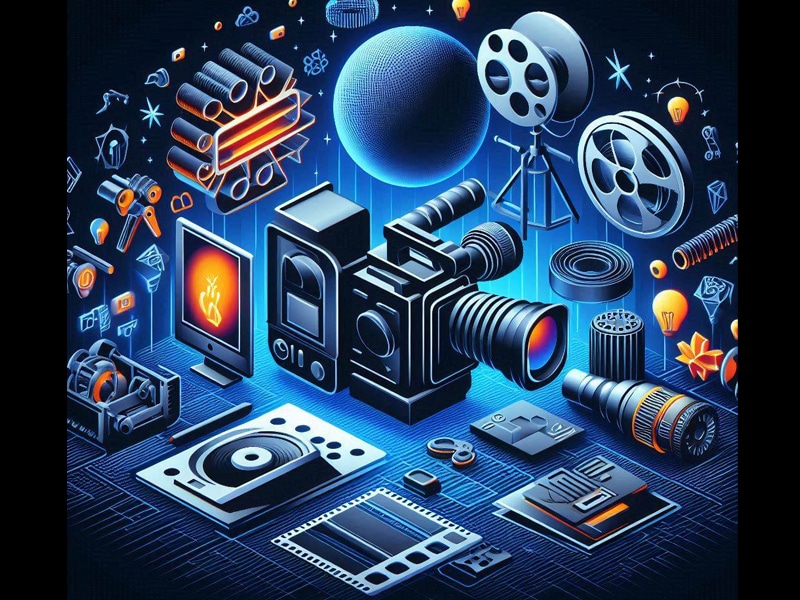From the early days of sequential photography to the advent of sound and color, from the the birth of CGI to the sophistication of the iPhone, the fusion of technology and film innovations has been remarkable. Here are new film technologies disrupting the entertainment industry.
Camera technology
The camera remains at the heart of film history, and yet, it has evolved in the most dynamic way. Early cameras were as large as a room, and they had limitations of movement and range. Today, it is perfectly possible to shoot feature length films on iPhones and mount them on drones. Fruitful R&D in machine vision lenses and micro-cameras indicates that these areas are poised to take over as new film technologies in the foreseeable future.
Algorithmic film/video editing
Algorithmic editing represents a union between contemporary practices and classical principles. In a nutshell, it involves managing the editing process according to a set of well-defined rules. New film technology has become increasingly digital by nature. Therefore, computer programming languages are becoming increasingly integrated into the future methods of video editing. Since computer programs involve complex sets of simple instructions, their definition and scope in film and video editing are vast.
Volume technology
Evolution in volume technology is one of the most exciting innovations in today’s entertainment sector. Just like classical film technology involved rear projection, contemporary volume technology involves the use of large LED walls to flash prerecorded images in the background of a shot while live-action elements are shot in the foreground. When this technology is paired with other tools of virtual production, it offers easy-to-customize, highly immersive solutions to digital film-making. This not only makes the production faster, but also amplifies the realistic feel of the VFX. Good examples involving the correct use of volume technology are The Mandalorian (2019) and The Batman (2022).
Mobile applications for the crew
Mobile technologies are both powerful and flexible. This makes mobiles a natural asset for the filmmaker’s gear box. Given this benefit, mobile production solutions have gradually begun to impact the day-to-day working culture of the sets. By and large, the administrative work of professional films has remained backward. Production teams continue to pester crew members for physical paperwork. Time cards are still processed manually and there is a big pile of important files that get lugged around from set to set. All this renders the production process inefficient. Mobile applications for the crew are poised to change that. Productions can pair mobile technology with other tools to optimize organization, communication and payment methods. They can also add to the safety factor of those in lower rungs of the hierarchy and thus help to create a better quality of life for the entire crew. A good example of mobile applications for crew would be Wrapbook. This app essentially enables production teams and crew members to be on the same page when it comes to documents, requests and payments.
3D printing
3D printing began its journey to reality back in the 1980s as a potential manufacturing and prototyping solution. Today, this technology can print everything from action figures to organ tissues, and it is setting its sights on film production. The 3D printing principles are being leveraged to push the limits of prop building, costume design, and more. This new technology has its unique strengths, in that it enables artists to quickly prepare three-dimensional objects with an intense level of detail that would otherwise require countless hours of human labor to be replicated by hand. Additionally, 3D printing also allows these objects to get altered with relatively limited effort. Thus it works on three levels: time-saving, cost-saving and increasing creative latitude.
3D previsualisation
3D visualization is basically a process of imagining and planning scenes and shots before filming begins. This practice commonly occurs in animation, video games and even still photography projects. It rose to prominence in the 1990s with Jurassic Park (1993) and has continued to evolve since then. Today, it is capable of conjuring fully immersive, digital replicas of the physical sets or locations to be used on a live-action production. The digital playgrounds of 3D pre-viz provide filmmakers the time and space to get creative without incurring unnecessary expenses. Even film directors can better refine visual designs, production designers can increase construction precision, directors of photography can take the guesswork out of technical solutions, and producers can optimize the logistical flow of entire productions using this method.

Real-time rendering
Real-time rendering has its origins in the world of gaming. However, it has proven to be a game-changer in film-making too. While CGI remains the go-to option for most productions, real-time rendering is becoming a more viable and efficient alternative as well. A good example of this method would be Avatar (2009). A judicious use of real-time rendering was used to create the Pandora universe, replete with alluring visuals. From traditional animation to green screen to hybrid film-making forms that are just now emerging, real-time rendering is changing the conversation for the ‘tech in entertainment’ circles everywhere.

To summarize, the future of technology in today’s entertainment sector is brighter and more expansive than ever before. This list is by no means exhaustive, but it does shed light on the key technological innovations coming to the fore in every corner of film/video production.

